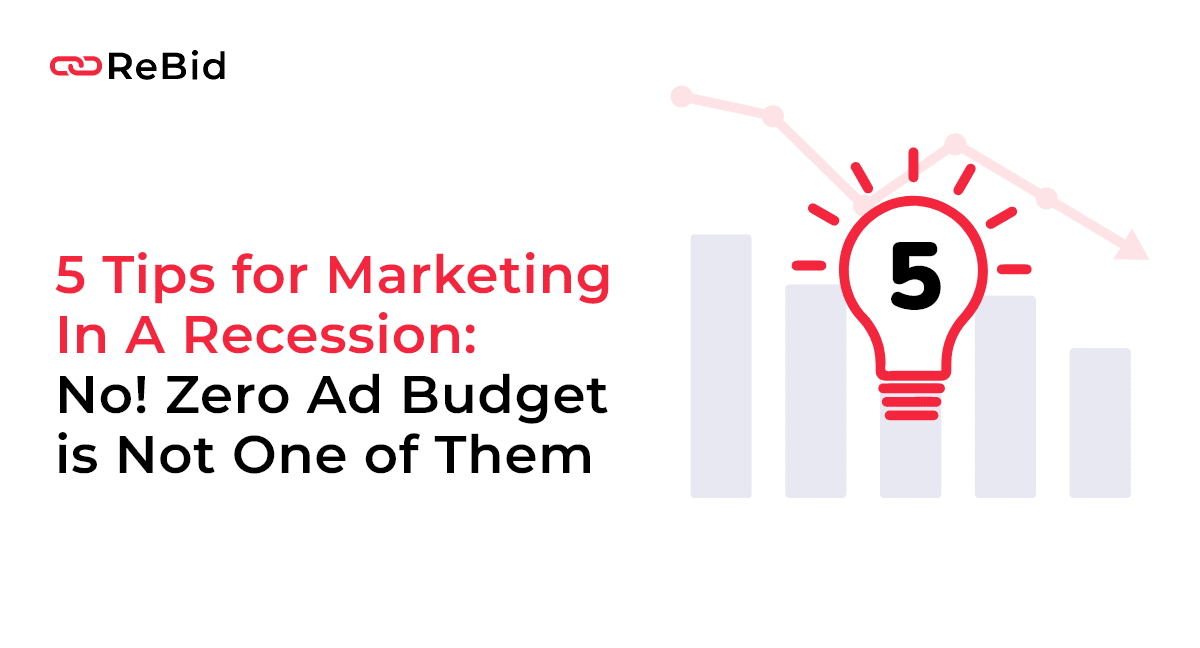Advice from a madtech SaaS platform born to solve advertising challenges in the pandemic
High inflation, layoff gloom and doom, share price dips, reduced spending and generally low consumer sentiments. The impending recession is undeniable. Businesses can already feel the impact even if economies try to downplay the turmoil. More than 80% of CEOs believe that a recession will occur in the next 12 months. This puts companies on a budget crunch, trying to save every penny in their cost centers. Unfortunately, conservative organizations often see Marketing In A Recession as the sacrificial lamb.
With the IMF predicting the worst for the coming year, is ditching advertising a smart move?
Does recession mean you should slash your advertising budget?
Several companies are cutting down their advertising budgets to survive the economic downturn. But a glance at the wisdom left behind by the Great Recession of 2008 tells a different story. If we are compromising marketing in the gloom and doom, we are doing it all wrong.
During the Great Recession, companies followed a similar trend, dropping the total advertising spend by 13%. But companies that continued to invest in marketing gained a 3.5x brand visibility and more profits.
Not to mention, this was during a time when ad hyper-personalization, deep insights into consumer behavior, and generating high ROI with performance advertising were not possible. In 2022, serving highly personalized ads and generating better returns with low budgets is possible. With adtech, martech, and madtech interventions befitting 2022 available, there are other answers than slashing the ad and marketing budget.
Businesses need an intelligent marketing strategy that brings more returns on smaller budgets. It’s time to do more with less.
Advertising and marketing in a recession: The essential tips
Tip 1: Focus on retention marketing
Building solid relationships with your previous customers is economical, especially during the recession. They are already several steps down the sales funnel and might only need a little push to make recurring purchases. Reward them for their loyalty while you are at it. For example, you can offer second-purchase discounts or create loyalty programs with great incentives for repeated purchases.
This approach is more cost-effective than new customer acquisitions and builds a loyal customer base that knows and loves your brand. By nurturing them, you will build a community of unofficial brand ambassadors, recommending your products to family and friends. Provide the right incentives, and you can drive sales through old and new customers, even on a tight budget.
Key takeaways:
- Create loyalty programs to encourage previous customers to make purchases.
- Nurture the relationship with loyal customers to earn referrals through word-of-mouth marketing.
Tip 2: Stay in tune with consumer sentiments
Recession is equally hard for businesses and consumers. As companies resort to large-scale layoffs and salary cuts, customers may be going through a financial crisis of their own. If you push them to purchase during such times, it will not only drive them away but also create a negative impression of your brand that your customers are not about to forget too quickly. Brands will struggle to recover from this even after the downturn.
Instead, build a strategy that makes your customers feel included. Be empathetic. Address their issues and prioritize making them feel understood while positioning yourself as a brand that meets their needs. This will not only get you more sales but also loyalty and word-of-mouth.
Key takeaways:
- Understand consumer sentiments and keep your messaging strategies in tune with their needs.
- Prioritize reputation marketing to build trust and avoid getting too spammy, salesy, or insensitive.
Tip 3: Get efficient with intelligent data and marketing automation
Recession demands a deeper understanding of shifting customer needs and priorities and advanced personalization for higher ROAS. Data-obsessed customer segmentation can help you achieve this. First-party data orchestration and activation enables you to study customer behaviors at scale and segment them based on specific attributes. You can then focus your ad budget on catering only to those most likely to purchase.
For example, you segment customers into two groups depending on their click and purchase behavior: the ones who spend impulsively and those who plan their purchases. Each group will respond differently to ad creatives. The impulsive segment may act on “limited-time offers.” At the same time, the second group might require ads that speak of sustainability and long-term product benefits.
And how can you build different ad creatives for these customer segments? Through marketing automation. Creating ads that address every group manually is time and budget-consuming, something which you cannot afford when marketing in a recession. Instead, automate the creative process to address individual segments in a fraction of the time and cost.
Key takeaways:
- Advertise to customers that are more likely to make a purchase, in turn increasing your return on ad spend.
- Automate data and marketing processes to cater to different customer segments with a limited budget.
Tip 4: Aggressively measure and optimize your campaigns
Marketing in a recession needs to generate the highest ROIs. It is not possible with a one-time strategy that doesn’t adjust to real-time inputs and changes. Instead, you need to measure KPIs in the short term, regularly update campaigns, and pivot strategies based on what’s working and what isn’t. Rely on KPIs that directly translate to revenue, such as the number of purchases rather than the number of clicks. Make sure you treat every served ad as a high-stakes investment that needs to be measured and optimized continuously.
This will help you identify areas that drain your marketing budget without generating profits. You can fix it by either generating new creatives or redirecting your resources to a different segment or channel altogether.
Key takeaways:
- Continuously measure ad campaign performance using reliable KPIs.
- Eliminate low-performing channels and segments and redirect resources to better-performing ones.
Tip 5: Invest in advertising and marketing SaaS
New technology investments may seem counterintuitive when you are on a budget. But when unified madtech SaaS platforms automate, track, and optimize your ad campaigns on subscription, you cannot afford to miss them when marketing in a recession. Especially because these platforms are designed to help you do more with less.
If you want to be ready for marketing in a recession, then data and technology are the answer. But adopting technology won’t happen overnight. Your employees need to be tech-ready to leverage the SaaS platforms during the recession. How to be prepared? By starting today.
Explore and adopt these three technologies to be recession-ready with the right platforms, partners, and budgets.
- Customer data platform: Analyzing customer behavior is key to hyper-personalized advertising. CDPs give you deep insights into online and offline customer behaviors, so you can identify customer segments that are highly likely to buy.
- Marketing automation: Recession is a time when you need to maximize the outcome from available financial and human resources. This calls for automation wherever possible, so your existing team can focus on areas that require human intelligence and creativity. Fortunately, advertising and marketing in a recession can be automated to build ads, onboard data, and create campaigns to improve your marketing ROI.
- Media buying automation: Buying and managing multiple ad spaces can be challenging, largely when catering to various customer segments. Media buying automation platforms can regulate and control media spending by purchasing ad spaces only when they are within your budget and catering to hyper-accurate customer segments. Managing and scaling ad space across channels is easier with automation.
Prepare for the advertising winter with ReBid
For brands of all sizes, marketing in a recession is a novel challenge. However, ReBid’s team of veterans has seen it all.
From small economic fluctuations to full-fledged recessions, ReBid understands what it’s like to be marketing in a recession with financial constraints. So we decided to simplify it for you with just the MADtech SaaS stack you need.
ReBid was born during the pandemic to help companies combat similar marketing challenges. We delivered on the promise by:
Controlling ad spends with ReBid Buy: An automated media buying platform that allows you to plan, manage and optimize ad spaces across all platforms.
Empathizing with shifting customer behaviors with ReBid Insights: A custom CDP that collects, analyzes and delivers insights on customer behavior across online and offline touchpoints.
Through these platforms, ReBid has helped brands save 40% on media budgets and improve ROAS by 30%. With reusable platforms and on-the-ball integrations, we are ready to deliver on your constraints during the upcoming downturn.
Want to join ReBid in building a sustainable marketing strategy for the recession? Request a demo today.





